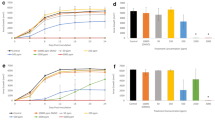Abstract
Insect repellents are topically applied to the skin and clothing of human and pet to keep flies, mosquitoes, and ticks away. Two important repellents, N,N-diethyl-meta-toluamide (DEET) and Picaridin, have been widely used since their discovery. Although repellency and toxicological effects of DEET and Picaridin on human being and insects are well documented without understanding molecular mechanisms, there have been no attempts to study their effects on microorganisms up to now. In the current study, DEET and Picaridin have been investigated for their antimicrobial characteristics against a broad range of microorganisms including bacteria, yeast, and fungi for the first time. They exhibited considerable antibacterial, anticandidal and antifungal properties. Even though bacteria was found to be more sensitive to Picaridin, yeast and fungi were more susceptible to DEET. Antimicrobial properties of these two repellents will increase the usage and application areas of the products containing DEET and Picaridin.
Similar content being viewed by others
References
Antwi FB, Shama LM, Peterson RK (2008) Risk assessments for the insect repellents DEET and picaridin. Regul Toxicol Pharm 51(1):31–36
Bohbot J, Fu L, Le T, Chauhan K, Cantrell C, Dickens J (2011) Multiple activities of insect repellents on odorant receptors in mosquitoes. Med Vet Entomol 25(4):436–444
Brown M, Hebert AA (1997) Insect repellents: an overview. J Am Acad Dermatol 36(2):243–249
Costanzo S, Watkinson A, Murby E, Kolpin D, Sandstrom M (2007) Is there a risk associated with the insect repellent DEET (N,N-diethyl- m-toluamide) commonly found in aquatic environments? Sci Total Environ 384(1):214–220
Debboun M, Frances SP, Strickman D (2007) Insect repellents: principles, methods, and uses. CRC Press, Boca Raton
Faergemann J, Hedner T, Larsson P (2005) The in vitro activity of pentane-1, 5-diol against aerobic bacteria. A new antimicrobial agent for topical usage? Acta Derm-Venereol 85(1):203–205
Frances SP, Debboun M, Frances S, Strickman D (eds) (2007) User acceptability: public perceptions of insect repellents. Insect repellents: principles, methods, and uses. Boca Raton, CRC Press
Galperin MY, Koonin EV (1999) Searching for drug targets in microbial genomes. Curr Opin Biotechnol 10(6):571–578
Gerdes SY, Scholle MD, D’Souza M, Bernal A, Baev MV, Farrell M, Kurnasov OV, Daugherty MD, Mseeh F, Polanuyer BM (2002) From genetic footprinting to antimicrobial drug targets: examples in cofactor biosynthetic pathways. J Bacteriol 184(16):4555–4572
Iscan Y, Hekimoglu S, Sargon M, Hincal A (2006) DEET-loaded solid lipid particles for skin delivery: in vitro release and skin permeation characteristics in different vehicles. J Microencapsul 23(3):315–327
Katz TM, Miller JH, Hebert AA (2008) Insect repellents: historical perspectives and new developments. J Am Acad Dermatol 58(5):865–871
Mwangi MM, Wu SW, Zhou Y, Sieradzki K, de Lencastre H, Richardson P, Bruce D, Rubin E, Myers E, Siggia ED (2007) Tracking the in vivo evolution of multidrug resistance in Staphylococcus aureus by whole-genome sequencing. P Natl Acad Sci USA 104(22):9451–9456
Öğütçü H, Sökmen A, Sökmen M, Polissiou M, Serkedjieva J, Daferera D, Sahin F, Barıs Ö, Gulluce M (2008) Bioactivities of the various extracts and essential oils of Salvia limbata CA Mey. and Salvia sclarea L. Turk J Biol 32:181–192
Osimitz T, Murphy J, Fell L, Page B (2010) Adverse events associated with the use of insect repellents containing N,N-diethyl-m-toluamide (DEET). Regul Toxicol Pharm 56(1):93–99
Poole K (1994) Bacterial multidrug resistance-emphasis on efflux mechanisms and Pseudomonas aeruginosa. J Antimicrob Chemoth 34(4):453–456
Qiu H, McCall JW, Won Jun H (1998) Formulation of topical insect repellent N,N-diethyl- m-toluamide (DEET): vehicle effects on DEET in vitro skin permeation. Int J Pharm 163(1):167–176
Sandstrom MW, Kolpin DW, Thurman EM, Zaugg SD (2005) Widespread detection of N,N-diethyl-m-toluamide in US Streams: comparison with concentrations of pesticides, personal care products, and other organic wastewater compounds. Environ Toxicol Chem 24(5):1029–1034
Sokmen A, Gulluce M, Askin Akpulat H, Daferera D, Tepe B, Polissiou M, Sokmen M, Sahin F (2004) The in vitro antimicrobial and antioxidant activities of the essential oils and methanol extracts of endemic Thymus spathulifolius. Food Control 15(8):627–634
Syed Z, Leal WS (2008) Mosquitoes smell and avoid the insect repellent DEET. P Natl Acad Sci USA 105(36):13598–13603
Zhang Y, Lewis K (1997) Fabatins: new antimicrobial plant peptides. FEMS Microbiol Lett 149(1):59–64
Acknowledgments
This research was supported by Yeditepe University. The authors deny any conflicts of interest.
Author information
Authors and Affiliations
Corresponding author
Rights and permissions
About this article
Cite this article
Kalaycı, S., Demirci, S. & Sahin, F. Determination of antimicrobial properties of Picaridin and DEET against a broad range of microorganisms. World J Microbiol Biotechnol 30, 407–411 (2014). https://doi.org/10.1007/s11274-013-1456-4
Received:
Accepted:
Published:
Issue Date:
DOI: https://doi.org/10.1007/s11274-013-1456-4




